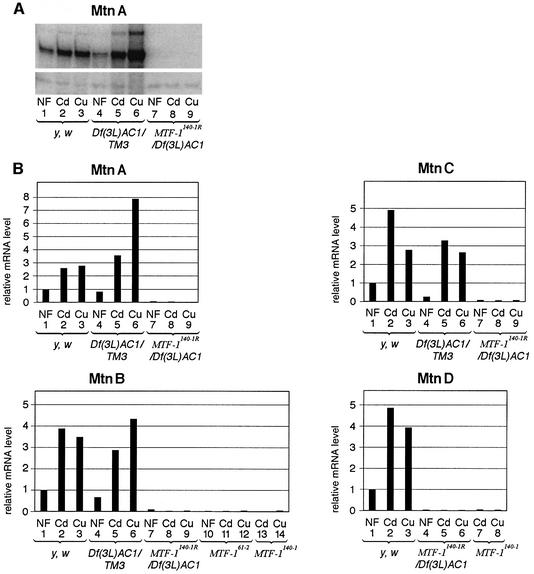Fig. 5. All four Drosophila metallothionein genes respond to heavy metal load and are dependent on MTF-1. Transcripts of metallothionein genes in Drosophila third instar larvae were determined by S1 nuclease protection (Weaver and Weissmann, 1979). Several MTF-1 mutant genotypes were used for this analysis, as indicated in the figure. NF = normal food; Cd = 50 µM CdCl2; Cu = 500 µM CuSO4. (A) Quantification of metallothionein (MtnA) transcripts. The lower part of the figure shows the signal from α-tubulin84B (loading control). (B) Compilation of the expression values of all four metallothionein genes (MtnA–D). Due to different specific activities of probes and hybridization optima, absolute transcript levels could not be compared easily between metallothionein genes. Therefore, the wild-type expression level in normal food was set arbitrarily to 1. Note that metallothionein expression in flies heterozygous for the MTF-1 locus is about the same as in y w flies wild-type for MTF-1 (compare lanes 1–3 of MtnA,B,C with lanes 4–6 of the same metallothioneins), while in MTF-1 mutants basal and metal-induced transcription activities of metallothionein genes are strongly reduced (compare lanes 1–3 of MtnA,B,C,D with lanes 7–9 of MtnA, lanes 7–14 of MtnB, lanes 7–9 of MtnC and lanes 4–8 of MtnD, respectively). MtnB expression is equally low with different mutant alleles: MTF-161-2, MTF-1140-1 and MTF-1140-1R (compare lanes 7–9 of MtnB with lanes 10–12, and with lanes 13 and 14).

An official website of the United States government
Here's how you know
Official websites use .gov
A
.gov website belongs to an official
government organization in the United States.
Secure .gov websites use HTTPS
A lock (
) or https:// means you've safely
connected to the .gov website. Share sensitive
information only on official, secure websites.
